mobile View, to the German Version tap the flag


- also: TAAF (FSAL)
- also: French Antarctic Ocean Territories
- Possession of France
- own name: Collectivité des Terres Australes et Antarctiques Françaises
• Flags
• Flag of the Administrator
• Meaning/Origin of the Flag
• Coat of Arms
• Meaning/Origin of the Coat of Arms
• Map
• Numbers and Facts
• Dependences:
– Kerguelen Archipelago
– Crozet Islands
– St. Paul
– New Amsterdam
– Adélie Land
– Scattered Islands (Îles Éparses)
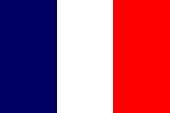
Flag of France,
ratio = 2:3,
Source, by: Corel Draw 4





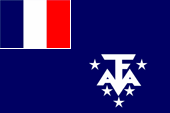
since 2007,
Flag of French Southern and Antarctic Lands,
ratio = 2:3,
Source, by: Wikipedia (EN)




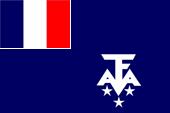
Flag of the Administrator of the French Southern and Antarctic Lands,
ratio = 2:3,
Source, by:
Wikipedia (FR)






All French colonies had no own flag over a long period. It had to be hoisted the French tricolor. This in principle usual until today. The status of the colonies changed over the years. Some of them are now overseas departments, and thus a ultraperipheric part of France and of the EU; others are overseas communities, autonomous, and not a part of France or the EU. Overseas departments belong – in contrast to the departments of the motherland – to no administrative region of France, they are a separate region. The "French Southern and Antarctic Lands" had initially not an own flag. Only the administrator of the territory had his own personal flag. It was blue with the French tricolour in the upper canton and carrys in the flying end a combination from the capitals of the country's name, completed by THREE stars. Those stood for the rank of the administrator, which was corresponding to that of an admiral. On 23rd of February in 2007 a flag was approved by decree, which was allowed to be hoist as a local flag beneath the flag of France. In appearance the flag almost corresponds to the flag of the administrator, but the TAAF-letter combination is surrounded by FIVE Stars. They represent the geographic regions from which the TAAF is composed: 1st Kerguélen Islands, 2nd Crozet Islands, 3rd Saint-Paul and Nouvelle Amsterdam, 4th Adelie Land, 5th Scattered Islands (Îles Éparses). The French Constitution was changed on 28th of March in 2003, and thus redefined the status of the French overseas possessions. Normally manages the Regional Council the local concerns in overseas communities (the TAAF is an overseas community), but there are in the French Southern and Antarctic territories no permanent residents, thus no elections and no legislature. The administrator performs these tasks.
Source:
Wikipedia (FR)


Coat of arms of the French Southern and Antarctic Lands,
Source, by:
Wikipedia (FR)

The coat of arms of the French Southern and Antarctic Lands (TAAF) was created by Suzanne Gauthier on behalf of the administrator of the TAAF in 1950. It shows a quartered shield, in the first field on blue a Kerguelen cabbage (represents the Kerguelen Archipelago), in the second field on gold a hummer (represents the islands of St. Paul and New Amsterdam), in the third box on gold a King Penguin (represents the Crozet Islands), and in the fourth field on blue an iceberg (stands for Adélie-Land); above the shield a golden rainbow with three golden stars and two anchors. Supporters are two elephant seals. The Îles Éparses are not represented on the coat of arms, they have been connected to the TAAF not until the year 2007.
Source:
Wikipedia (FR)

Location:
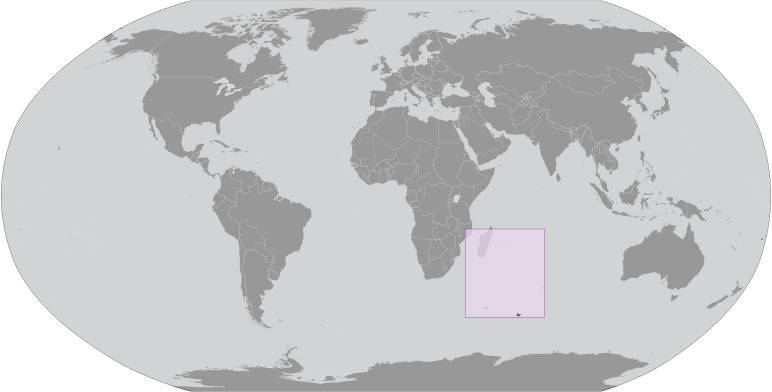
Source: CIA World Factbook
Map of the country:
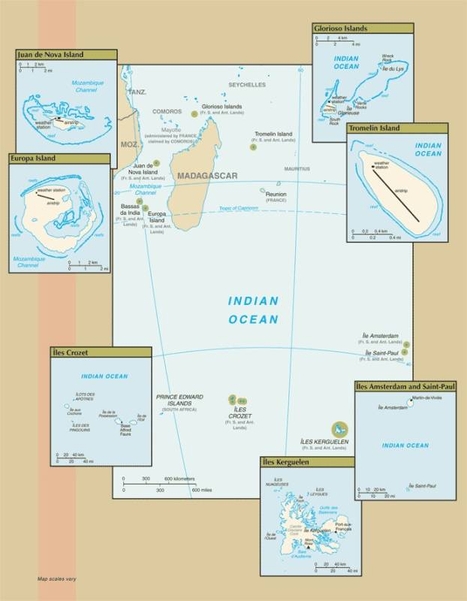
Source: CIA World Factbook
Map of Adélie Land:
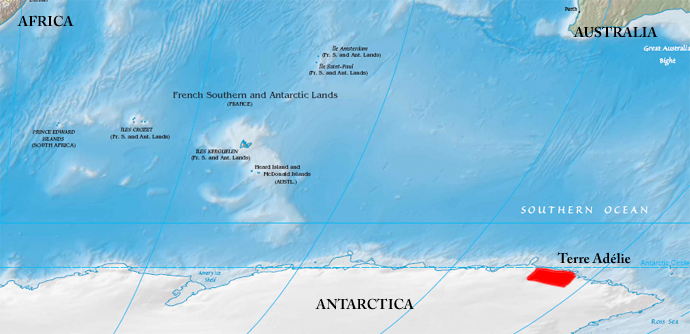
Source: Freeware, University of Texas Libraries, modyfied by: Volker Preuß

Area: 169.884 square miles (see Dependences)
Inhabitants: ca. 210 (no permanent inhabitants), merely crews of scientific stations, with them casual fishermans, seal and whale hunters
Seat of administration: Saint Pierre (on Réunion)
official Language: French
Currency: 1 Euro (€) = 100 Cent
Time Zones:
· on the Scattered Islands and Crozet Islands: GMT + 1 h,
· on Kerguelen, Saint Paul and New Amsterdam: GMT + 3 h,
· on Adélie Land: GMT + 9 h
History: (see Dependences)
Source:
Wikipedia (DE)

consisting of: main island Grande Terre (2 577 sq.mi.), Îles Nuageuses, Îles Howe, Îles Foch, Îles du Port, Îles Normandes, Îles Altazin, Île de l'Ouest und Îles Gaby, in total 2 786 sq.mi., none permanent inhabitants, merely crews of the scientific stations Port-aux-Français, La Montjoie and Cabane Port-Raymond, with them casual fishermans, seal and whale hunters
History:
1772 · discovered by Yves Joseph de Kerguelen-Trémarec
1893 · French colony, administrated from Madagascar
1942–1944 · German fleet base
1950 · establishment of a first scientific station
1955 · formation of the "Territory of French Southern and Antarctic Territories" (TAAF), the Kerguelen Islands get incorporated to the TAAF

consisting of: Île aux Cochons, Îles des Pingouins, Îles de Apôtres, Île des la Possession and Île de l'Est, in total 184 sq.mi., 15 inhabitants (none permanent inhabitants), merely crews of the scientific stations La Petite Manchotière, La Grande Manchotière and Base Alfed-Faure, with them casual fishermans, seal and whale hunters
History:
1772 · discovered by Crozet and Marion-Dufresne
1893 · French colony, administrated from Madagascar
1955 · formation of the "Territory of French Southern and Antarctic Territories" (TAAF), the Crozet Islands get incorporated to the TAAF
1964 · establishment of a first scientific station

3 sq.mi., uninhabited,
History:
1522 · discovered by Portugese seafarers
1893 · French colony, administrated from Madagascar
1955 · formation of the "Territory of French Southern and Antarctic Territories" (TAAF), Saint Paul gets incorporated to the TAAF

23 sq.mi., none permanent inhabitants, merely crews of the scientific station Martin-de-Viviès
History:
1522 · discovered by Portugese seafarers
1893 · French colony, administrated from Madagascar
1955 · formation of the "Territory of French Southern and Antarctic Territories" (TAAF), New Amsterdam gets incorporated to the TAAF

150 580 sq.mi. of antarctic area, none permanent inhabitants, merely crews of the scientific station Dumont d'Urville
History:
1840 · discovered by Dumont d'Urville
1924 · French colony, administrated from Madagascar
1955 · formation of the "Territory of French Southern and Antarctic Territories" (TAAF), Adélie Land gets incorporated to the TAAF
1959 · through the Antarktic Convention the French sovereignty-rights in Adélie Land get restricted

The Scattered Islands (Îles Éparses) are French possessions and former dependencies of Réunion. They are mainly placed in the west and north of Madagascar. Since 2005, they are managed by the administrator of the colony "French Southern and Antarctic Lands (TAAF)", and in 2007 they became fully annexed to the TAAF.
• Tromelin Island, area: 0,4 sq.mi., inhabitants: ca. 20 (station staff)
• Europe Island, area: 11 sq.mi., inhabitants: ca. 12 (military and station staff)
• Bassas da India, area: 0,07 sq.mi., uninhabited
• Juan de Nova, area: 2 sq.mi., inhabitants: ca. 12 (military and station staff)
• Glorieuses Islands, area: 1,5 sq.mi., inhabitants: ca. 12 (military and station staff)
Source:
Wikipedia (FR),
Wikipedia (DE),
Länder der Erde


![]()













